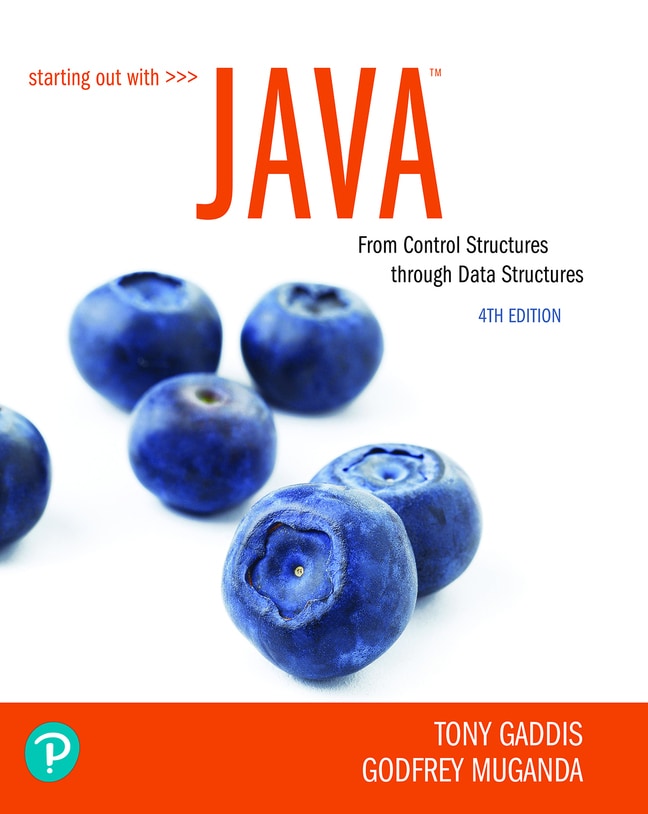
Starting Out with Java: From Control Structures through Data Structures, 4th edition
Your access includes:
- Search, highlight, notes, and more
- Easily create flashcards
- Use the app for access anywhere
- 14-day refund guarantee
$10.99per month
Minimum 4-month term, pay monthly or pay $43.96 upfront
Learn more, spend less
-
Listen on the go
Learn how you like with full eTextbook audio
-
Find it fast
Quickly navigate your eTextbook with search
-
Stay organized
Access all your eTextbooks in one place
-
Easily continue access
Keep learning with auto-renew
Overview
Starting Out with Java is a step-by-step introduction to programming in Java designed for a 2- or 3-semester sequence. It covers everything from the fundamentals of Java programming to algorithms and data structures. As with all Gaddis texts, every chapter contains clear and easy-to-read code listings, concise and practical real-world examples, and an abundance of exercises.
In the 4th Edition, JavaFX replaces Swing as the standard GUI library for Java in chapters that focus on GUI development. The Swing and Applet material from the previous edition is available online. Several new, motivational programming problems have been added throughout. 3 chapters discuss basics of GUI applications with JavaFX, CSS styling and advanced user interface controls, and 2D shapes, animation, visual effects, playing audio and video, and responding to mouse and keyboard events.
Published by Pearson (July 14th 2021) - Copyright © 2019
ISBN-13: 9780137502813
Subject: Programming - Introductory
Category: Java
Overview
- Introduction to Computers and Java
- Java Fundamentals
- Decision Structures
- Loops and Files
- Methods
- A First Look at Classes
- Arrays and the ArrayList Class
- A Second Look at Classes and Objects
- Text Processing and More about Wrapper Classes
- Inheritance
- Exceptions and Advanced File I/O
- JavaFX: GUI Programming and Basic Controls
- JavaFX: Advanced Controls
- JavaFX: Graphics, Effects, and Media
- Recursion
- Sorting, Searching, and Algorithm Analysis
- Generics
- Collections and the Stream API
- Linked Lists
- Stacks and Queues
- Binary Trees, AVL Trees, and Priority Queues
Online Appendices
- Appendix A: The ASCII/Unicode Characters
- Appendix B: Operator Precedence and Associativity
- Appendix C: Java Key Words
- Appendix D: Installing the JDK and Using the JDK Documentation
- Appendix E: Using the javadoc Utility
- Appendix F: More about the Math Class
- Appendix G: Packages
- Appendix H: Working with Records and Random Access Files
- Appendix I: Configuring JavaDB and Installing Apache Derby
- Appendix J: The QuickSort Algorithm
- Appendix K: Named Colors
- Appendix L: Answers to Checkpoints
- Appendix M: Answers to Odd-Numbered Review Questions
Online Chapters
- Chapter 22: Databases
- Chapter 23: A First Look at GUI Applications with Swing
- Chapter 24: Advanced Swing GUI Applications
- Chapter 25: Applets and More
Online Case Studies
- Case Study 1: Calculating Sales Commission
- Case Study 2: The Amortization Class
- Case Study 3: The PinTester Class
- Case Study 4: Parallel Arrays
- Case Study 5: The FeetInches Class
- Case Study 6: The Serial Number Class
- Case Study 7: A Simple Text Editor Application
Your questions answered
When you purchase an eTextbook subscription, it will last 4 months. You can renew your subscription by selecting Extend subscription on the Manage subscription page in My account before your initial term ends.
If you extend your subscription, we'll automatically charge you every month. If you made a one‑time payment for your initial 4‑month term, you'll now pay monthly. To make sure your learning is uninterrupted, please check your card details.
To avoid the next payment charge, select Cancel subscription on the Manage subscription page in My account before the renewal date. You can subscribe again in the future by purchasing another eTextbook subscription.
When you purchase a Channels subscription it will last 1 month, 3 months or 12 months, depending on the plan you chose. Your subscription will automatically renew at the end of your term unless you cancel it.
We use your credit card to renew your subscription automatically. To make sure your learning is uninterrupted, please check your card details.